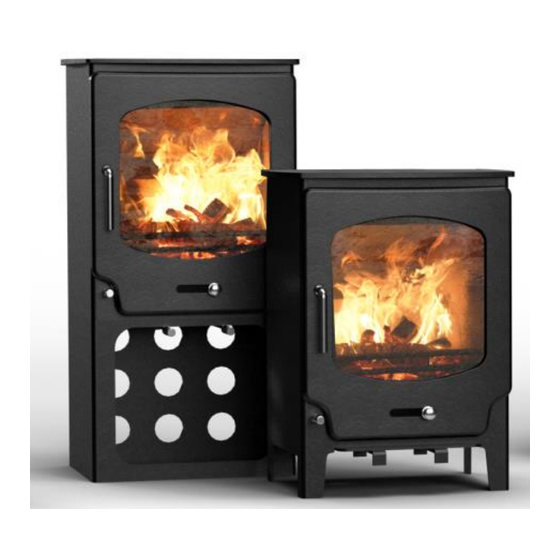
Table of Contents
Advertisement
Saltfire ST-X4, 5, 8
INSTALLATION AND OPERATING INSTRUCTIONS.
INTRODUCTION
SAFETY
Safety is the most important consideration when using and installing your stove. If not installed and used
correctly, a house fire could result. Installation must comply with relevant national and local Building
Regulations and fire safety standards.
IN THE EVENT OF CHIMNEY FIRE, EVACUATE THE PROPERTY AND CALL THE EMERGENCY SERVICES.
Your stove will be heavy, and care needs to be taken when lifting - 2 people will normally be required to lift.
UNPACKING
Your stove will have several of its components stored inside the stove itself for transportation.
The flue spigot can also be bolted to the flue outlet – the stove has two options for flue outlet – one on the
top and one at the rear. - Most people use the top outlet but depending on where you intend to position the
stove in relation to your chimney, you may wish to use the rear outlet – in this case, remove the blanking
plate at the rear and secure into the top outlet instead.
Underneath the grate will also be an ash-pan which will require regular emptying.
You will also find a glove which must be used when opening the door or when adjusting air vents when the
fire is hot.
1
Advertisement
Table of Contents

Summarization of Contents
Installation and Safety
Introduction
Provides an overview of the manual's content and purpose.
Safety
Details crucial safety considerations for stove installation and use.
Unpacking
Explains the process of unpacking the stove and its components.
Installation
Covers requirements and standards for proper stove installation.
Operation and Fuel Management
Operating Instructions
Guidance on the correct use of the stove and its features.
Fuel
Information on suitable fuel types, preparation, and usage.
Air Inlet Controls
Explanation of how to adjust air vents for optimal combustion.
Lighting the Fire
Step-by-step instructions for safely starting a fire.
Essential Instructions Before Use
Crucial 'tempering-in' process for new stoves.
Ignition
Detailed guide on the ignition process for the stove.
Refuelling
Proper procedures for adding fuel to maintain the fire.
Maintenance and Troubleshooting
Cleaning/Maintenance
Routine cleaning procedures and maintenance tasks for the stove.
Troubleshooting Solutions For Stove Problems
Diagnosing and resolving common issues encountered with the stove.
Stove is difficult to light / keep lit
Common causes and solutions for lighting and keeping the fire lit.
Fuel burns too quickly
Reasons why fuel might burn too fast and how to address it.
Smoke comes back into room
Identifying causes and solutions for smoke entering the room.
Glass gets dirty quickly
Factors contributing to dirty stove glass and cleaning tips.
Not enough heat being produced
Troubleshooting insufficient heat output from the stove.
Too much heat in room
Addressing issues of excessive heat in the room.
Grate deformed / Baffle plate deformed
Causes and implications of grate or baffle plate deformation.
Emergency Procedures and Warranty
What to do in the event of a chimney fire:-
Steps to take in case of a chimney fire.
Warranty
Details of the stove's limited warranty and registration process.
Service Records
Section for logging service history and maintenance dates.



Need help?
Do you have a question about the ST-X8 Tall and is the answer not in the manual?
Questions and answers